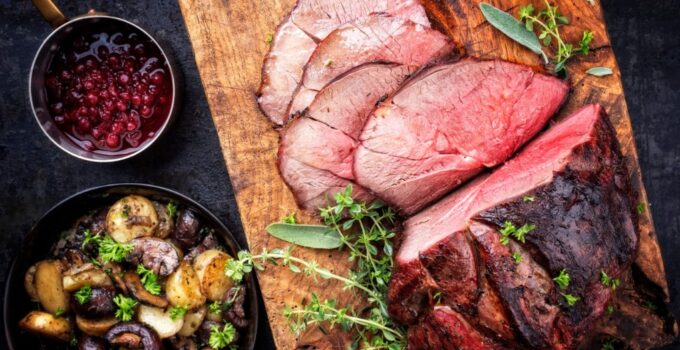Venison, the crown jewel of game meats, is making an increasingly popular appearance in home kitchens across the UK. Revered for its lean composition and robust flavor profile, this meat requires a level of finesse to achieve a meal that is memorable for all the right reasons.
But fret not; whether you’re an aspiring home cook or an experienced culinary aficionado, we’ve got the definitive list of do’s and don’ts when it comes to preparing venison.
The A-List ─ The Do’s of Venison Preparation

Source: livestrong.com
Use the Right Cuts for the Right Dish
Venison is versatile but understanding the appropriate cut for your intended dish can make all the difference. Steaks and fillets work great for grilling or pan-frying, while shoulders and legs are better suited for slow-cooking methods like stews and casseroles.
Marinate to Enhance, Not Mask
Given venison’s distinctive flavor, the temptation might be to marinate it heavily. However, simpler is often better. Ingredients like garlic, rosemary, and a dash of olive oil can enhance the meat’s natural flavor without overwhelming it.
Master the Art of Searing
Achieving a golden-brown crust through a high-heat sear will not only make your venison more aesthetically appealing but will also lock in its natural juices. Just ensure your pan is scorching hot before you lay down that beautiful cut of meat.
Rest the Meat
After cooking, let your venison rest before slicing into it. This allows the juices to redistribute throughout the meat, resulting in a moist and tender bite.
Pair Wisely
Venison pairs excellently with bold red wines and dark ales. Root vegetables and earthy sides like a parsnip purée can also complement the robustness of the meat.
The Offenders ─ The Don’ts of Venison Preparation

Source: handsourced.com.au
Don’t Overcook
Venison is a lean meat, meaning it has less fat to keep it moist during cooking. Overcooking can quickly turn your beautiful cut into a leather-like disappointment. Aim for medium-rare to medium for most recipes.
Don’t Rush the Thaw
If your venison is frozen, allow ample time for it to thaw in the fridge. Rushing this process can compromise the texture and flavour.
Don’t Ignore the Silver Skin
Venison often comes with a silvery membrane known as the “silver skin.” Remove this before cooking to prevent the meat from becoming too tough or chewy.
Don’t Use Dull Knives
When it comes to venison, precise cuts can make or break your dish. A sharp knife ensures you get the most out of your meat, whether you’re trimming, dicing, or slicing.
Don’t Underseason
Venison has a robust flavour, but that doesn’t mean it won’t benefit from proper seasoning. A generous pinch of good-quality salt and freshly cracked black pepper can elevate your dish to the next level.
A Cut Above ─ How to Handle Venison Safely
View this post on Instagram
Handling and Storage
- Keep it chilled ─ Venison should be stored at temperatures no higher than 4°C.
- Use or freeze ─ Fresh venison should be cooked or frozen within 1-2 days of purchase.
Cooking Temperatures
- Medium-rare ─ Cook to an internal temperature of 55°C.
- Medium ─ Aim for an internal temperature of 60°C.
Proper Equipment
- Thermometer ─ Investing in a quality meat thermometer can be a game-changer.
- Quality cookware ─ Cast-iron skillets and high-quality roasting pans can provide more consistent cooking temperatures.
One Step Further ─ Venison Specialties

Source: peaktoplate.com
For the more adventurous, consider the following:
- Venison jerky ─ A great way to preserve the meat while making a tasty snack.
- Venison sausages ─ Mix with fattier meat like pork to create your bespoke sausages.
Whether it’s a formal dinner party or a cozy family meal, venison offers a gastronomic experience like no other. Armed with these do’s and don’ts, you’re now ready to venture into the realm of venison cooking with newfound confidence.
Go on, impress your guests, and most importantly, yourself. After all, good food is just the beginning; it’s the stories and memories we create around the dining table that make each dish truly exceptional. Cheers!
What is the key to selecting the right cut of venison for a dish?
Choose cuts based on the cooking method; steaks and fillets are ideal for grilling, while shoulders and legs work well for slow-cooking methods like stews.
How should one approach marinating venison to enhance its flavor?
Keep it simple; use ingredients like garlic, rosemary, and olive oil to enhance the natural flavor without overpowering it.
Why is searing an important step in venison preparation?
Searing at high heat not only creates an appealing crust but also locks in natural juices, enhancing both taste and presentation.
Why is it recommended to let venison rest after cooking?
Allowing the meat to rest redistributes juices, resulting in a moist and tender texture when sliced.
What are some recommended pairings for venison to complement its robust flavor?
Bold red wines, dark ales, and earthy sides like parsnip purée are excellent choices to complement the richness of venison.
Why should venison be cooked to medium-rare to medium for most recipes?
Overcooking can make venison dry due to its lean nature; aim for medium-rare to medium to preserve its moisture.
Why is it essential to remove the silver skin from venison before cooking?
The silver skin, if not removed, can make the meat tough or chewy, affecting the overall texture of the dish.
What are the recommended handling and storage practices for fresh venison?
Store venison at temperatures no higher than 4°C, and cook or freeze fresh venison within 1-2 days of purchase for optimal quality.
Why is it crucial to avoid rushing the thawing process for frozen venison?
Rushing thawing compromises texture and flavor; allow ample time for venison to thaw in the fridge.
Why is using a sharp knife emphasized when working with venison?
Precise cuts are vital for venison dishes; a sharp knife ensures clean cuts, enhancing the overall cooking and dining experience.
Is seasoning important when working with venison, considering its robust flavor?
Yes, venison benefits from proper seasoning; a generous pinch of good-quality salt and black pepper can elevate the dish.
What are the recommended storage temperatures for venison?

Source: tastingtable.com
Venison should be stored at temperatures no higher than 4°C to ensure freshness and safety.
What internal temperature should be aimed for when cooking venison to medium-rare? Cook venison to an internal temperature of 55°C for a perfect medium-rare result.
How can a quality meat thermometer enhance the venison cooking experience?
A meat thermometer ensures accurate cooking temperatures, preventing overcooking and ensuring optimal taste and texture.
Why is investing in quality cookware, like cast-iron skillets, recommended for venison cooking?
Quality cookware provides more consistent cooking temperatures, contributing to better results when preparing venison.
What are some adventurous venison specialties to try beyond traditional recipes?
Consider making venison jerky for a tasty snack or mixing venison with pork to create bespoke sausages for a unique culinary experience.







